 username@email.com
username@email.com
Now we will focus on some of the diversity of living eukaryotic organisms in order to understand how life has evolved. We will start small and then move on to bigger and more familiar organisms later.
We reviewed the basics of cell form and function, including the differences and similarities among prokaryotes, eukaryotes, plants and animals.
Algae (singular alga) are unicellular or simple multicellular organisms that photosynthesize. It is likely that the six taxonomic divisions of algae known today arose from a common ancestral eukaryotic cell. Three of the six divisions are made up mostly of unicellular organisms; the other three are mainly multicellular, and the vast majority of algae are photosynthetic. Algae range in complexity from a single cell to a filament of cells to a solid body of cells that somewhat resembles a plant. The divisions of algae are based on the presence, number, and position of flagella; their pigmentation; and other factors, like how they store food. The components of the algal cell wall, which often feels slimy due to its polysaccharides, also distinguish different algae.
Most single-celled algae occur on the surface of the ocean or freshwater bodies, where they are known as plankton. Unicellular algae are free-living autotrophs, though some may live in colonies. Multicellular algae occur primarily in shallow waters along shorelines. Divisions of algae have been named for the algae’s dominant pigment, which may hide the greening of the chloroplasts. Each Division is discussed and described below.
Division Euglenophyta consists of about 1,000 species of the ubiquitous Euglena. These unicellular freshwater algae contain chloroplasts encased in a three-layer membrane, suggesting that Euglenas evolved by ingesting and incorporating green algae, which have a two-layer chloroplast membrane.
Euglenas are generally elongated, two-flagellum cells, with many chloroplasts that give the cell its striking emerald-green color. Euglenas have a photoreceptor and are remarkable in that they be either heterotrophs and/or autotrophs. In sunlight, Euglenas are green and photosynthetic autotrophs, but put them in a dark closet and they lose their pigmentation and become heterotrophs.

Generalized structure of Euglena
Division Chrysophyta includes the diatoms (approximately 10,000 species), the golden-brown algae (approximately 1,500 species), and the smaller group (approximately 600 species) of yellow-green algae. Chrysophyta are characterized by the presence of chlorophylls a and c; fucoxanthin, a yellow-brown pigment present in all except the yellow-greens; silicon-impregnated cell walls (lacking cellulose); and their storage of food as oil rather than starch.
Diatoms are famous for their beautiful, lacey double shells made of silica. The lacey look of the shells are actually pores that allow passage of materials into and out of the alga. Diatoms, like most plankton, are an important part of the marine food chain. Unlike their Divisional relatives, which reproduce via binary fission, diatoms sometimes reproduce sexually via a fusion of gametes, called syngamy.
Division Pyrrophyta, or fire algae, is made up of about 1,000 species of single-celled marine dinoflagellates. Most species are photoautotrophs, but some are heterotrophs; most have two flagella. Dinoflagellates come in a variety of bewilderingly weird forms, kept in shape by rigid cellulose walls. A few are naked, and most of these are parasitic. As their name suggests, most fire algae are red. They are often the culprits in occurrences of toxic red tides. Some dinoflagellates (especially Gessnerium catenellum) that form red tides release neurotoxins, which have caused massive fish kills and occasional poisoning of humans who ingest it in filter-feeding mussels and other shellfish.
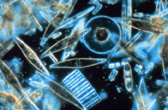
Diatoms
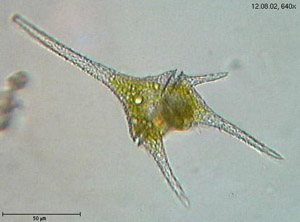
Example of a typical dinoflagellate
Division Chlorophyta contains the green algae, which may be either unicellular or multicellular. Chlorophyta are characterized by their chlorophylls a and b (as in plants), the presence of beta-carotene photosynthetic pigments, and their storage of food as starch. Most have cellulose in their cell walls. They are believed to be the ancestors of plants. Most green algae are freshwater organisms, although some are marine organisms; some of the 7,000 species in this Division live on tree trunks or in symbiosis with other organisms. The Chlorophyta are unique in that some species in this Division are multicellular. Scientists speculate that multicellularity may have arisen from this Division.
Scientists believe that there are three pathways that lead from unicellularity to multicellularity. The first arose from colonies of single-celled organisms. A colony is a group of independently functioning, single-celled organisms connected to each other via strands of cytoplasm. There are four genera of multicellular Chlorophytes. In order of complexity they are: Chlamydomonas, Gonium, Pandorina, and Volvox. Volvox is a hollow sphere whose single outer layer is comprised of as many as 60,000 minute flagellated cells.
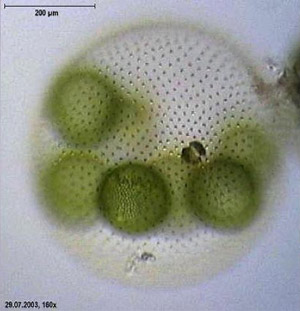
Volvox are the prototypical colonial alga
The second path toward multicellularity is really an intermediate form of organization, referred to as coenocytic. In this case, a single organism consists of many nuclei in a common cytoplasm. Nuclear divisions are not accompanied by separation of the cytoplasm or the formation of cell walls. Coenocytic algae include the large Valonia and the filamentous Cladophora.
The third road to multicellularity is represented by algae that undergo nuclear division as well as division of the cytoplasm and the formation of cell walls. Because of this type of cell division, these algae may occur in sheets, filaments, or even a three-dimensional form. One green algae species that evinces this type of multicellularity is Spirogyra.
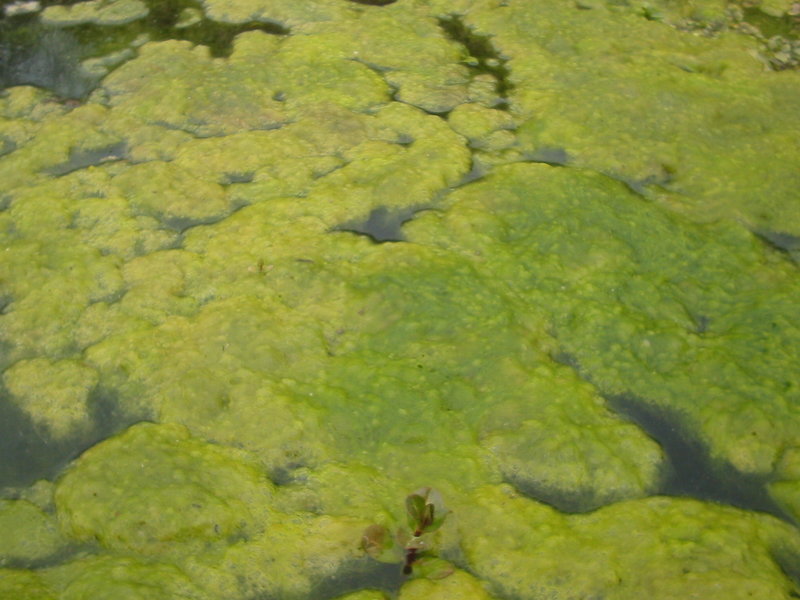
Example of a mat of Spirogyra
There are two Divisions that contain only multicellular algae, phaeophyta and rhodophyta. Division Phaeophyta consists of brown algae—the seaweeds that thrive in cold marine waters. Kelps are members of this Division and occur, sometimes in huge water-forests, offshore in cooler climes. Many species occur along rocky shorelines, where their holdfasts, the kelp equivalent of roots, keep them anchored to the rocks and prevent them from being washed away by battering waves. The body of a multicellular alga is called a thallus, which consists of the holdfast, the stem-like stipe, and the leaf-like blade. Though these structures are likened to similar structures in plants, their internal organization is very different, and they resemble plant structures only superficially. The rockweed, Fucus, is a typical species in this Division.
The Division Rhodophyta, the red algae, consists of about 4,000 species of mostly tropical and subtropical marine seaweeds (very few species are freshwater). Their red color is conferred by the presence of phycobilins, and they also contain chlorophylls a and d, as well carotenoids. Because of these pigments, Rhodophyta can survive at great depths, up to 175 meters below the surface. Some red algae have a slimy, mucilaginous outer layer, though others—the coralline algae—deposit calcium carbonate in their cell walls and are important in reef building.
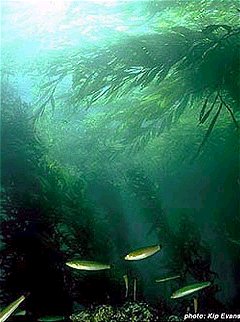
Example of kelp forest
Eukaryotes are characterized by the presence of
The correct answer is C. Prokaryotes have naked strands of DNA, while eukaryotes have their DNA on chromosomes in the nucleus. Both prokaryotes and eukaryotes have plasma membranes. Eukaryotes are not characterized by cilia or flagella, and all cells have DNA.
Which of the following is a form of multicellular algae?
The correct answer is D. Kelp are members of Division Phaeophyta, which contains only multicellular algae. Diatoms are unicellular algae with rigid silicon shells, so A is incorrect. Volvox are colonies of independent unicellular algae, so B is not correct. Chlorophyta is a Division of algae that includes both unicellular and multicellular algae, so C is not correct.
The word protozoa means “first animals” and it refers to the animal-like organisms in various phyla of the Kingdom Protista. Protozoa are unicellular heterotrophs, mainly free-living or parasitic. They reproduce asexually via binary fission, though some have sexual cycles and others undergo conjugation, or nucleus exchange between cells. Protozoa are organized into phyla based primarily on their mode of locomotion:
Phylum Mastigophora contains the most primitive protozoa, which generally have two whip-like flagella, though larger members of this phylum may have many. Most Mastigophora reproduce asexually via binary fission, though some reproduce sexually or through syngamy. Most Mastigophora are parasites, though some are free-living; many have no cell wall and are able to form pseudopodia (brief extensions of the cell body) used for locomotion or to engulf prey. Among the parasitic Mastigophora is the flagellate Trypanosoma gambiense, which causes African sleeping sickness, transferred to humans by the nefarious tse-tse fly. Members of the genus Trichonympha are symbionts in the gut of termites and help them digest wood.
Phylum Sarcodina contains the ever-popular amoebas, for whom the formation and use of pseudopodia is a way of life. Locomotion solely with pseudopodia is called streaming. Amoebas create pincer-shaped pseudopodia to catch and engulf prey, a process called phagocytosis. The prey is then drawn into the cell and digested. The cell is sensitive to the chemical stimulus of nearby prey and streams toward its victim when it detects the prey’s chemical signals. Although amoebas are nonphotosynthetic, they do have photoreceptors. When a pseudopodium is exposed to bright light, the amoeba withdraws it and streams away. Interestingly, if an entire amoeba is exposed to constant strong light, it will eventually learn to live with it and carry on its normal behavior.
Sarcodines reproduce both asexually via mitosis (but without breakdown of the nuclear envelope), or sexually via meiosis and the formation of gametes and zygotes. Sarcodines are usually free-living and found mainly in salt water and fresh water, and some, like the one that causes amoebic dysentery, are parasites. Some Sarcodines stiffen their pseudopodia with protective spines made from microtubules (e.g., Actinosphaerium).
Foraminifera, the most common of all protozoans, produce beautiful and delicate shells of calcium carbonate extracted from ocean water. The shells of dead Foraminifera have accumulated on the seabed or on cliffs over time, creating million-year-old foraminiferanooze. Britain’s White Cliffs of Dover are made from Foraminifera skeletons. Another Sarcodine group, the radiolarians, also has skeletons that form a radiolarian ooze on the ocean bottom.
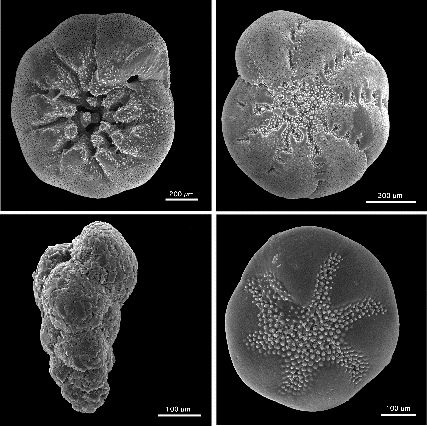
Example of some foraminifera tests
Phylum Ciliophora contains another popular protozoan, the paramecium. As the phylum’s name suggests, its members move by the rapid beating of the cilia on the outside of the cell. In some Ciliophora, the cilia bind together to form clumps called cirri or brush shapes called membranelles, both of which actually enable the cell to “jump” or “walk” along on these stiffened protrusions. Cilia arise from cilia basal bodies, which coordinate the even, sequential movement of cilia that propel the cell. Ciliophora have both contractile vacuoles, which rid the cell of liquid, and food vacuoles that fill with enzymes when food particles are swept into it. Ciliophora, oddly, have two types of nuclei, the micronuclei and the macronuclei, which have a very complicated mode of genetic communication. Each cell may have one or more of each type. Reproduction involves conjugation, in which genetic information is transferred through direct contact between the cells. During Ciliophora conjugation, micronuclei undergo meiosis, and the two cells exchange haploid micronuclei, which then fuse to form diploid micronuclei. One macronucleus dissolves, and a new one develops from one of the diploid micronuclei.
Like amoebas, paramecia are responsive to external stimuli, including subtle changes in the temperature and chemistry of their environment. A paramecium’s cilia beat constantly, directing water toward an oral groove that is forever sampling the environment. Negative stimuli, such as the presence of a toxic substance, cause a paramecium to stop dead in its tracks and beat a hasty retreat. If the negative stimulus is not so dire—a change of temperature, for example—the paramecium will simply turn or move away.
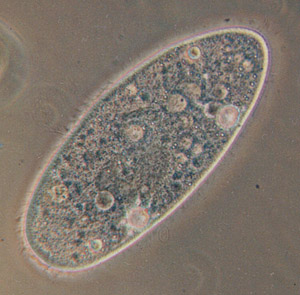
Example of a paramecium
The organisms in the Phlyum Opalinida are evenly covered in cilia or flagella and have at least two nuclei (though not the differentiated nuclei of the Ciliophora). Opalinids produce gametes that fuse to form a zygote. Most members of this phylum live their lives in the guts of frogs and toads, or sometimes in the digestive tracts of fish and reptiles.
All members of the Phylum Sporozoa are parasites, and some, like the malaria-causing Plasmodium, are quite nasty. All Sporozoa lack cilia and flagella, and have no means of locomotion. Sporozoa produce spores as part of their complex life cycle. Plasmodium begin life in an amoeboid state, as sporozoites, in the bloodstream of a warm-blooded host. Asexual reproduction occurs in the host’s liver and the resulting merozoites enter the bloodstream and cause malaria. There they reproduce asexually in red blood cells and causing the cells to explode. Eventually the merozoites enter a sexual stage, when they are called gamonts, which produce gametes. A mosquito will pick up gamonts when it bites an infected person. Then fertilization occurs and zygotes develop in the insect’s gut. The oocysts (fertilized eggs) divide asexually to produce sporozoites, which travel to the mosquito’s salivary glands. The next bite transfers the sporozoites to their next victim. Malaria is still one of the top five most lethal diseases in the world.
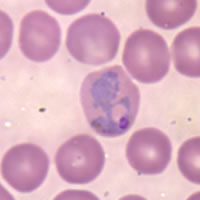
Example of the Malaria parasite, Plasmodium vivax in a human red blood cell
Which phylum contains protozoa that use pseudopodia almost exclusively as their means of locomotion?
The correct answer is B. Sarcodines, which include the amoebas, create pseudopodia and use them to move via streaming. Most Mastigophora use mainly flagella, Opalinida use cilia or flagella for locomotion, and Ciliophora use cilia exclusively.
The skeletons of which protozoan genus accumulate on the ocean floor to form an ooze?
The correct answer is C. Radiolarians create calcium carbonate shells that accumulate on the ocean floor when the organisms die. Paramecia do not form rigid outer coverings, Trypanosomes are Mastigophora that have no cell walls (and that cause sleeping sickness), and Plasmodium are parasites that cause malaria.
Which phylum includes the most pathogenic parasites?
The correct answer is D. All members of the Phylum Sporozoa are parasitic and many are pathogens. Sarcodina contains some pathogenic parasites, but most members of this phylum do not. Opalinida live symbiotically in the guts of amphibians or reptiles, and Ciliophora are ciliates that are generally neither parasitic nor pathogenic.
Phagocytosis is accomplished by which of the following structures?
The correct answer is A. A pseudopodium is a temporary extension of the cell body, as in an amoeba, that engulfs prey, which is then ingested. This is the process of phagocytosis. Paramecia have an oral groove that receives food that is swept in by cilia, and also have food vacuoles that receive food from the oral groove. A membranelle is a tuft of cilia used for locomotion in Ciliophora.